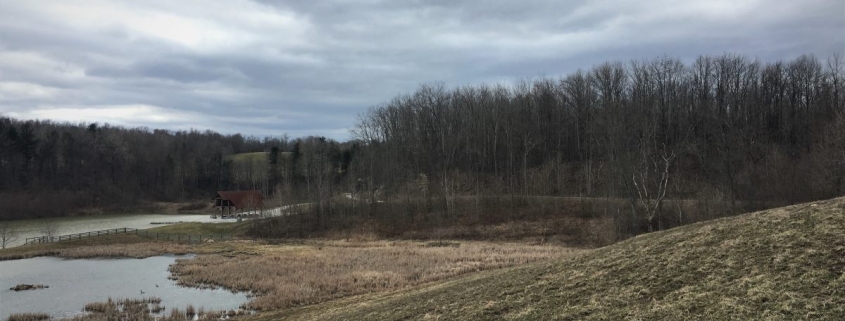Mid-March Revelations on “Worn-Out” Land!
I returned mid-March to the site of my east-central Ohio Land Legacy Project, an 1,100 property that nineteenth-century agriculture brought to ruin. Poor practices led to wholesale erosion, impoverished land, and abandoned farms. Mid-twentieth century strip mining led to more “scars upon the land,” perhaps, in retrospect for this property, opening the door to reclamation and a return to a viable agricultural enterprise. The owners manage the property for cattle and recreation, and view the land as a legacy for grand children and many generations beyond. I previously introduced readers to the project in May 2018: https://stevejonesgbh.com/2018/05/29/idyllic-pastoral-earth-stewardship-surprise-exemplar/
I completed my field work and family interviews in March. As I prepare my final report for the family, allow me to share with you some observations, reflections, and photos.
Two New Days Dawning
I stayed three nights and devoted three days to the tasks at hand. Never one to permit dawn to escape my notice, I captured early dawn (lower left) and later the sun’s first peek above the horizon (below right) on the first morning. Crepuscular rays grace the upper right of the sunrise image. I snapped both photos from the lakeside cabin where I stayed, an extraordinary place to nest while “working” on such a professionally fulfilling project. Somehow, the word “work” implies something in the way of drudgery, challenge, and unpleasant effort. Nothing could be further from the truth. I found instead a high return in satisfaction and reward.
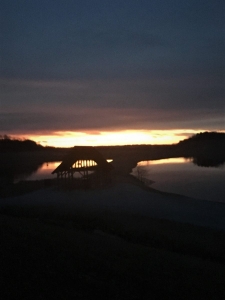
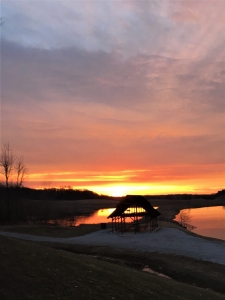
Day two dawned with comparable glory, first early dawn and then sunrise. Who could ask for anything more. I’ll repeat a John Muir quote I applied just last week in my Post on lecturing at Bryn Athyn College. One hundred thirty years ago, Muir observed, When we contemplate the whole globe as one great dewdrop, striped and dotted with continents and islands, flying through space with other stars all singing and shining together as one, the whole universe appears as an infinite storm of beauty. Imagine 1.7 square miles of abused agricultural land further despoiled by strip-mining, and now rehabilitated to the point of this old forester seeing it representing an infinite storm of beauty!
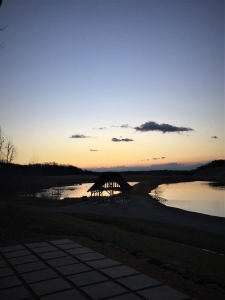
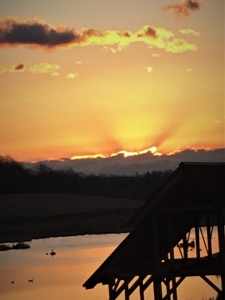
I would have depicted a third morning had it dawned with other than full overcast, blustery winds, and snow flurries.
Panorama of “Worn-out” Land
The two late afternoon views below, both from the residence patio, are to the north (left) and east (right), providing a good sense of the lay of the land. To the north, the property abuts adjoining land within a few hundred yards. The property extends beyond the distant woods line to the east.
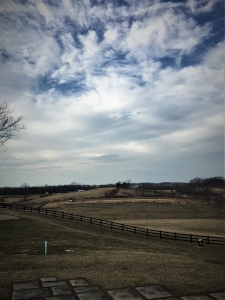
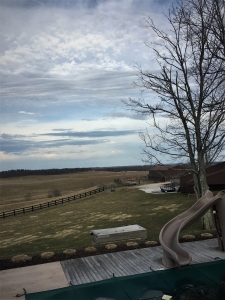
Hard to imagine a 100-foot high-wall dropping away about where the fence row is now!
Evidence of Past Abuse and Signals of Recovery
Just beyond that east side wooded ridge, the non-reclaimed, 50-foot high-wall (below left) reveals the harsh character of the stripping that once came within 100 feet of the residence. This high-wall predates even Ohio’s earliest reclamation regulations. Frankly, I am glad that it remains untouched. Without it, I would have no window into the sandstone, shale, mudstone, and occasional limestone strata underlying the original surface. Nor would I have some gauge on the pace of natural healing. The stripping stopped here because the overburden to coal seam thickness ratio exceeded an economic threshold. At some fifty years, the high-wall is collapsing into the cut basin. Coltsfoot (Tussilago farfara; lower right), among the region’s earliest spring ephemerals, is sending up a few blossoms, which precede its leaves by several weeks. By the end of March, the scree slopes would have been dressed in the gold of thousands of blooms.
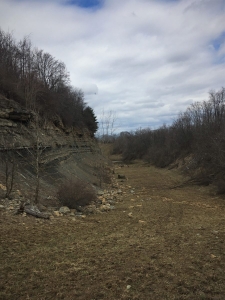
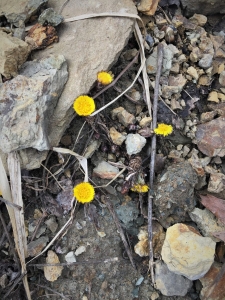
The high-wall and basin extending to the south is shallower and nearly grown over with advancing forest. Nature knows how to handle disturbance, whether natural or machine-induced. Imagine perhaps a few hundred years from now, when even a discerning forester would struggle to interpret the anthro-geomorphology that led to the then current landscape.
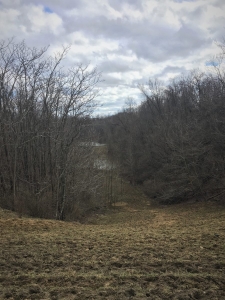
A Big Surprise Hidden to My August 2018 Explorations
When I walked and studied the property last August, I viewed the 60-year-old forest on the non-reclaimed debris heap above the cabin with amazement. Here is my preliminary summary from August 2018:
Stripped in about 1960, the heap has healed remarkably well [An August note to myself: I need to find out from the current owner what if anything might have been done to revegetate or return topsoil. What did the 1947 regulations actually require?] My quick circuit tallied 14 tree species: sweetgum; ash; red maple; silver maple; elm; red oak; sycamore; black cherry; hickory; walnut; hawthorn; black locust; American beech; yellow poplar. [Note — I found big tooth aspen in March, bringing the total to fifteen tree species.] Were any of these planted? I cored a red oak and counted 58 annual rings, confirming the 1960 or so strip mine abandonment. I am astounded by tree species richness, stand density, and dominant tree heights. Granted, the stand is variable, ranging from excellent stocking to scattered individuals. Site quality also varies dramatically. Dominant tree height approaches 80 feet in places… 50 feet in others. All in all, however, I would not have anticipated the expressed level of recovery and rehabilitation.
I exposed a surface soil profile near the summit. I struggled to dig even to eight inches. Coarse, sharply-fractured stone dominates the profile. The fragments are generally less than two inches, including far more fines than I had expected. The forest floor comprises a surprisingly thick organic layer and leaf litter. Roots are exploiting the entire profile. A distinct A-horizon suggests excellent soil development and organic matter incorporation. Soil formation is underway.
The debris heap photo below is obviously from March during the dormant season, which from this angle I would never have guessed is anything but a natural forest on undisturbed soil. Without understory vegetation to limit my view into the forest at eye level, evidence of intentional revegetation leaped into view. How could I have missed the obvious last August?
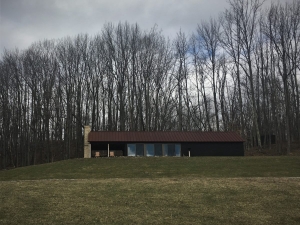
I found row after row of planted sweetgum (Liquidambar styraciflua) running vertically from bottom to top of the heap. I found no other species in rows. Interestingly, the natural range of sweetgum does not extend into east-central Ohio, growing naturally only in the very southern part of the state along the Ohio River.
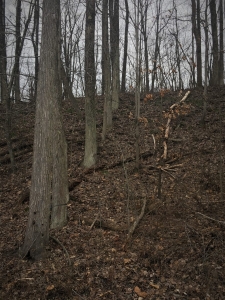
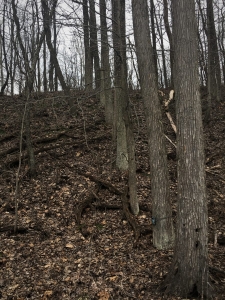
The landowner, a gentleman who is a student of his land (a scholar in many regards), had likewise not noticed the rows. From the debris heap summit, I found parallel planted rows lining the old access trail down the south hillside to the marsh just west of the cabin. For those not familiar with sweetgum seed pods, see below right. The owner indicated that Hannah Coal had mined this particular site. He will determine what records might exist to tell us more about the tree planting plan and action.
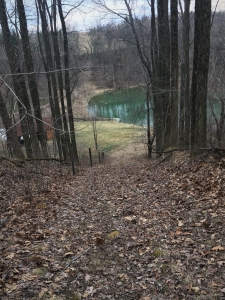
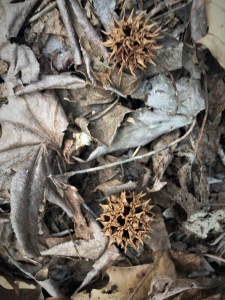
I have observed multiple times that every thing in Nature has a story to tell. Overlay the hand (and machines) of man and the stories multiply.
Flourishing Renewal
Still at the debris heap, I found a 28-inch diameter (4.5 feet above the ground) red oak (below left) at the summit. What is its origin? An acorn fortuitously cached by a squirrel at a spot where machinery had deposited an especially rich and thick dressing of topsoil during whatever reclamation transpired? Perhaps the tree planting crew had been directed to plant only the sweetgum in straight rows on the steeper side-slopes, and randomly plant a mix of other species on the flatter summit. Maybe they planted the oak seedling in a spot where the dibble found deeper soil among the rocks in the debris pile. Sixty years ago as machinery stripped and then moved on leaving the debris heap, the now forty-inch diameter hickory (below right) stood witness at the southeast base of the heap, already at least half-a-century old. Why did operators not disturb it? Did it provide welcome shade for workers? Like the red oak and the planted sweetgum, the hickory has a story of human and natural actions.
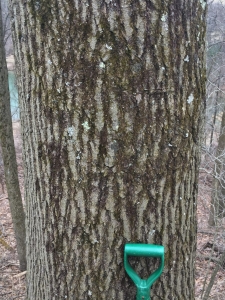
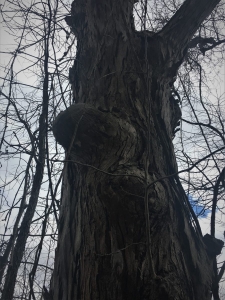
Again, Nature knows disturbance… and has evolved over eons the tools to persevere, recover, and flourish. Five hundred years ago Leonardo Da Vinci observed, “Human subtlety will never devise an invention more beautiful, more simple or more direct than does nature because in her inventions nothing is lacking, and nothing is superfluous.” Nature knows disturbance!
Multiple Use — Wildlife
This wasted, scarred, and desecrated land is not at all what many would have presumed based upon its history of strip mining. The pond and marsh (below) lie just west of the cabin. Everything within sight derived from stripping and some degree of reclamation. Firewood cut from regenerated forest warms the cabin and fuels the grill. Beavers populate the property and their dam (lower right) supplements pool depth.
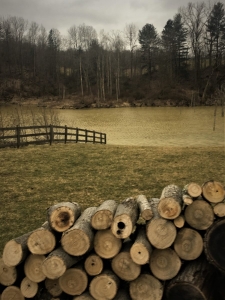
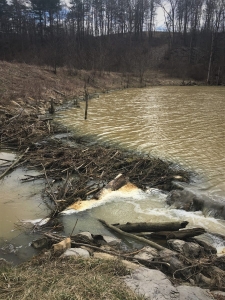
The landowner permits trapping for family, friends, and acquaintances. One such trapper a week before my March visit harvested these two beavers.
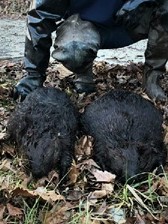
Deer are abundant on the property. I often saw groups of 3-7 individuals. The family issues permission to hunt to selected friends and family.
Multiple Use — Oil and Gas
Dark afternoon clouds accent the gas well-pad mid-property. Gas lines, access roads, and worker movement and activity complicate cattle operations, yet the above and below ground operations are generally compatible.
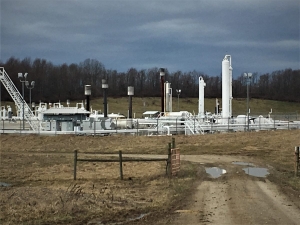
Multiple Use — Cattle
Cattle production stands as the primary commercial land use, yet I submit that the overall principal management tenet is Earth stewardship. The equipment barn and cattle handling facility occupy the over-size utility building that served the strip mining company that the family owned prior to starting the current cattle business. Haylage to hold the cattle until spring green-up lies encased in plastic below right.
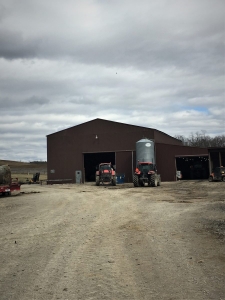
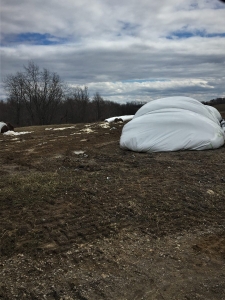
These cattle await their afternoon repast near the barn.
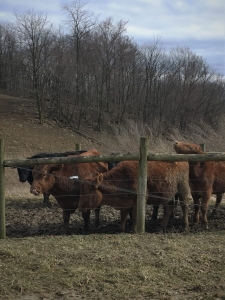
Multiple Use — Recreation
I took this photo from the east, looking westward toward the cabin and the forest atop the debris heap. Do you see any evidence of strip mining? Had someone dropped me blindfolded at the lake’s eastern end, I would not have known. Yet the 17-acre lake is a strip mine product as is every other facet of the within-view landscape. This part of the property provides robust recreational escape for the family. The pavilion in the foreground of the sunrise photos served as the location for the wedding of one son. I relished my August 2018 and March 2019 nights at the cabin.
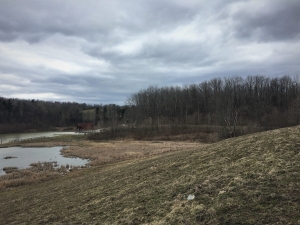
As I accepted my bachelors of forestry degree in 1973, the US government was drafting and debating federal strip mine regulations and laws. The President signed the Surface Mining Control and Reclamation Act of 1977. I celebrated because I had seen first-hand the scarred central Appalachians near my home in western Maryland. I had no idea that 46 years after graduation that I would be performing a Land Legacy evaluation on a property a hundred miles from my home, leading me to recognize that the line between devastation and remediation can be fuzzy. Unintended consequences aren’t always negative. That the initial strip mining devastation on this project property was more land salvation than ruin. Things aren’t always what they appear to be.
Our role as Earth stewards begins with recognition and embrace of obligation, carries through commitment to action, and results in generations-long pledges to retain and improve some small corner of the world through wisdom, knowledge, and hard work. I interviewed the owners and all four of their adult children. Without exception, the family sees this unit of Mother Earth as a legacy for many generations yet to come. I feel truly privileged and honored to help tell the tale of their love and devotion to the land and its future.
Life Lessons and Wisdom from Developing an Ohio Land Legacy Story
Louis Bromfield, an Ohio-born novelist and playwright who devoted his life to rehabilitating the soil on his old worn-out farm (Malabar) near Mansfield, summarized a similar zeal and ethic:
The adventure at Malabar is by no means finished… The land came to us out of eternity and when the youngest of us associated with it dies, it will still be here. The best we can hope to do is to leave the mark of our fleeting existence upon it, to die knowing that we have changed a small corner of this earth for the better by wisdom, knowledge and hard work.
I’ll offer broadly and succinctly that embracing and practicing Earth stewardship is reward and fulfillment in and of itself. I discerned four distinct lessons from developing this Post:
- Nature knows disturbance — learn to harness her wisdom.
- Very few things are as they first appear.
- So much in Nature lies hidden within.
- Earth stewardship is a multi-generational commitment of passion and action.
Thoughts and Reflections
I wrote my books (Nature Based Leadership (2016) and Nature-Inspired Learning and Leading (2017)) and the two scheduled for 2019 (Weaned Seals and Snowy Summits: Stories of Passion for Place and Everyday Nature and Natural Elixir: Lifting Your Life through Nature’s Inspiration) to encourage all citizens to recognize and appreciate that every lesson for living, learning, serving, and leading is either written indelibly in or is powerfully inspired by Nature. Both published books are available on Amazon and other online sources.
Again, here are the four succinct lessons I draw from this Blog Post:
- Nature knows disturbance — learn to harness her wisdom.
- Very few things are as they first appear.
- So much in Nature lies hidden within.
- Earth stewardship is a multi-generational commitment of passion and action.
Inhale and absorb Nature’s elixir. May Nature Inspire and Reward you!
Note: All blog post images created & photographed by Stephen B. Jones unless otherwise noted. Please circulate images with photo credit: “©2019 Steve Jones, Great Blue Heron LLC. All Rights Reserved.”
Another Note: If you came to this post via a Facebook posting or by an another route, please sign up now (no cost… no obligation) to receive my Blog Post email alerts: https://stevejonesgbh.com/contact/
And a Third: I am available for Nature-Inspired Speaking, Writing, and Consulting — contact me at steve.jones.0524@gmail.com
Reminder of my Personal and Professional Purpose, Passion, and Cause
If only more of us viewed our precious environment through my own filters. If only my mission and vision could be multiplied untold orders of magnitude:
Mission: Employ writing and speaking to educate, inspire, and enable readers and listeners to understand, appreciate, and enjoy Nature… and accept and practice Earth Stewardship.
Vision:
- People of all ages will pay greater attention to and engage more regularly with Nature… and will accept and practice informed and responsible Earth Stewardship.
- They will see their relationship to our natural world with new eyes… and will understand more clearly their Earth home.
Tagline/Motto: Steve (Great Blue Heron) encourages and seeks a better tomorrow through Nature-Inspired Living!

